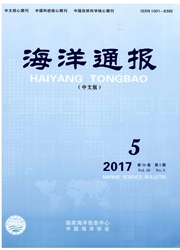

 中文摘要:
中文摘要:
利用ROMS海洋数值模式对2006年冬季渤黄海的海洋动力环境进行模拟,基于温度、盐度模拟结果,使用谱混合模型进行水团分析,定义了渤海海峡地区的水交换区。并进一步讨论了冬季大风事件对水交换区的影响,给出了冬季大风影响下的渤黄海水交换特征。研究得出,冬季的黄海水团以"舌"形分布于渤海海峡地区,水交换区则表现为沿"舌"形边缘呈带状分布,具有西北--东南的走向趋势,并且在"舌"尖处的水交换面积最大。通过缩小研究范围,发现位于黄海最北部的沿岸海域并不参与渤黄海之间的水体交换。最后研究发现,冬季大风事件对渤海水交换具有促进作用,具体表现为:大风过程使黄海暖流对渤海的入侵更加深入,水交换区向渤海方向伸展,南部的水交换带变宽,河流径流进入渤海后与渤海水的混合区加大,并发生北移。
 英文摘要:
英文摘要:
This paper used ROMS ocean numerical model to simulate the ocean dynamic environment of Bohai Sea and the Yellow sea in winter of 2006. On the basis of the simulation results of temperature and salt, this study used the spectral mixture model to analyze the water mass and define the water exchange area in the Bohai Strait. Apart from that,the paper discussed the effect of high wind on the water exchange area and obtained the variation characteristics of water exchange area under the influence of high wind. The main research achievements are as follows. The distribution of the Yellow Sea water mass in the Bohai strait is similar to the " tongue" and the water exchange area presents the zonal distribution along the " tongue" edge. It has northwest-southeast direction and the area at the tip of the " tongue" is biggest. The coastal waters at the north end of the Yellow Sea don't participate in the water exchange. High wind can promote the water exchange. Specifically, high wind reinforces the invasion of the Yellow Sea warm currents to the Bohai Sea and the exchange area stretches in the Bohai Sea. The south of the water exchange area is wider. The water mixing area between the river runoff and the Bohai Sea increases and moves northward.
 同期刊论文项目
同期刊论文项目
 同项目期刊论文
同项目期刊论文
 Impact of Preceding El Nino and the Indian Ocean Dipole on the Southern China Precipitation in Early
Impact of Preceding El Nino and the Indian Ocean Dipole on the Southern China Precipitation in Early 期刊信息
期刊信息
